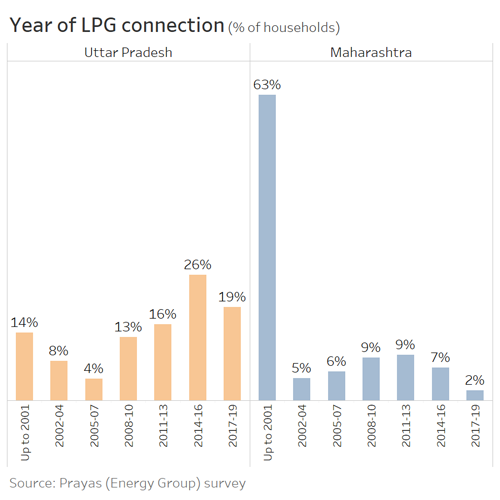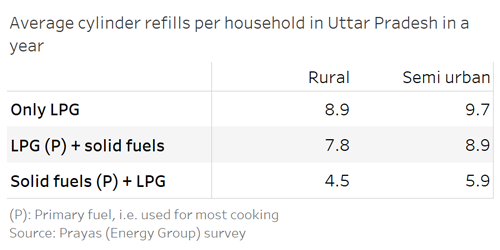Prayas (Energy Group) conducted a survey of 3000 households in semi-urban and rural areas of Uttar Pradesh and Maharashtra to understand their energy end-use patterns. This survey was conducted in February-March 2019. ECHO is a series of blog posts presenting the key findings of the survey. This post discusses households’ use of energy for cooking.
Sampling plan and household categorization are briefly described here.
Cooking is one of the most basic energy needs in a household. In 2011, about 70% of the households in India used solid fuels for cooking. In 2015, indoor air pollution from the use of solid fuels for cooking was estimated to have caused over 1 lakh premature deaths, mostly women and children. Interventions to eliminate the use of solid fuels have ranged from subsidized smokeless chulhas to subsidized LPG connections. The most recent programme Pradhan Mantri UJJWALA Yojana has provided about 8 crore free LPG connections to poor households between 2016 and 2019.
The survey findings show LPG ownership is high in both states. About 91% of the surveyed households in Uttar Pradesh and 96% in Maharashtra have LPG connections. Households in Maharashtra have been using LPG for much longer than those in Uttar Pradesh (see Figure 1). About 19% of the surveyed households in Uttar Pradesh and just about 2% in Maharashtra got LPG connections after 2016 when PMUY was launched. Hence, the share of PMUY beneficiaries in our survey sample is small.

Figure 1: Year of LPG connection for surveyed households
The actual use of LPG connections for cooking is also observed to be high in both states. About 67% of the households in Uttar Pradesh and 95% in Maharashtra use LPG for most of their cooking. This is a commendable change, particularly in Uttar Pradesh, where the LPG connections are more recent. However, the use of solid fuels has not completely stopped. Many studies have reported use of multiple fuels by households mostly constrained by affordability and availability of LPG cylinders. This is also observed in our survey. About 45% of all the surveyed households in Uttar Pradesh and 12% in Maharashtra still use solid fuels for part or all of their cooking. In Uttar Pradesh, about 82% of the households using solid fuels already have an LPG connection. In low income rural households, about 41% of the surveyed households use solid fuels for most of their cooking in spite of having an LPG connection (see Figure 2). Another 24% only use solid fuels for cooking. Households in other income categories of Uttar Pradesh have shifted to higher use of LPG. In medium and high income households of semi-urban areas, about 80-90% of households use LPG for most of their cooking. This is comparable to Maharashtra where more than 90% of all the households in all income categories and semi-urban/rural areas use LPG for all or most of their cooking.

Figure 2: Fuels used for cooking in surveyed households
Number of LPG cylinder refills is another indicator for the use of LPG for cooking. In Uttar Pradesh, the number varies significantly depending on the stacking of the fuels and whether the household is rural or semi-urban (see Table 1). The average annual refills for households using only LPG for cooking is about 9, twice the number of refills done by households with LPG connections but still using solid fuels for most of the cooking. Households in semi-urban areas use about a cylinder more than their rural counterparts. These numbers are comparable to those in Maharashtra, where households in both rural and semi-urban areas refill the cylinder about 9 times each year on average, the range being 7 to 9.5. Two points should be noted here. First, households in Uttar Pradesh are larger (6.9 people per household) than those in Maharashtra (4.7 people per household). Second, about 31% of the households in Maharashtra use LPG to heat water for bathing as compared to about 13% in Uttar Pradesh. We will discuss our findings on water-heating in the next post but the exact attribution of these factors to the actual requirement of LPG in a household, and its use for cooking, needs to be examined.

Table 1: Average cylinder refills per household in Uttar Pradesh in a year
We also asked the households their reasons for the continued use of solid fuels. Households without LPG connections are less than 10% in both the states and are primarily in rural low income category. Half of these households reported LPG being expensive as a reason for not getting a LPG connection while the other half reported non-availability of LPG. About 70% of the households without LPG connection in Uttar Pradesh and 67% in Maharashtra have heard about the PMUY programme. In case of households with LPG connections but not using it for all their cooking, the reasons are somewhat different. Most of these households are in Uttar Pradesh. Around 55% of these households find LPG too expensive to use for all the cooking. About 60% of the households who find LPG too expensive report getting subsidy sometimes or never. Overall about 54% of the surveyed households with LPG connections in Uttar Pradesh and 85% in Maharashtra report getting regular subsidy payment. Furthermore, about 60% of the households who find LPG too expensive get their solid fuels for free. This further adds to their perception of LPG being expensive. Finally, about 20% of the households with LPG connections but using solid fuels quote reasons other than affordability and availability. The most common other reason is the preference for the taste of food cooked over the chulha.
High ownership of LPG connections in both the states has the potential of eliminating the use of solid fuels for cooking and consequently the adverse health impacts associated with it. It is encouraging to notice that even though more than 60% of surveyed households in Uttar Pradesh got an LPG connection only after 2010, LPG usage in these households is significant except for rural low-income households. At the same time, interventions are needed to push for sustained and exclusive use of LPG in these households. Subsidy quantum and its disbursal can be made more effective as a majority of the households not using LPG for all their cooking still find it expensive. Interventions to address gender, behavioural, and cultural barriers for adoption of LPG are also required. There are other cleaner fuels like electricity, biogas, and piped natural gas that can be used, as LPG may not be preferred or appropriate choice for all the households. We find almost negligible adoption of these in the surveyed households but interventions to facilitate their adoption can be designed and implemented. In Maharashtra, although most of the households have adopted the exclusive use of LPG for cooking, they still use solid fuels for water heating, contributing to the local air pollution. More on this in the next post.
Please contact Aditya Chunekar (
Click here to access other posts in the blog
This post was translated and published by Eklavya in their Hindi magazine Srot (Vigyan evam technology features). This translation is available here.


